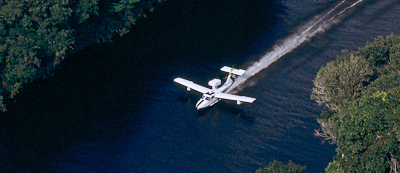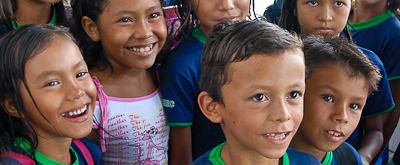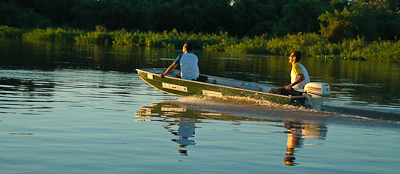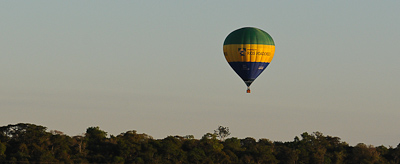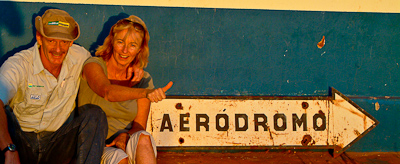English
BRASIL DAS ÁGUAS or The Waters of Brazil project
Aviator Gérard Moss who, in 2001, successfully completed the first flight around the world by motor-glider (Wings of the Wind), completed another innovative expedition in 2003/2004. Aboard a Lake Renegade amphibian aircraft named Talha-mar (Skimmer), he carried out a unique survey of the water quality of Brazil’s principal rivers, lakes and reservoirs.
Brazil harbours around 12-15% of the Earth’s fresh water reserves. The project, which started in October 2003 and ended in December 2004, took him and his wife Margi to the farthermost reaches of this vast country, the 5th largest in the world. Margi accompanied him as project photographer and was responsible the cataloguing and separating the water samples to be sent off to different laboratories for analysis.
In addition to obtaining valuable data on the country’s fresh water reserves, one of the key objectives of the project was to increase public awareness of the importance of preserving this critical and increasingly scarce resource. Actively supported by companies and institutions committed to Brazilian environmental issues, such as Petrobras, Embratel, CVRD (Companhia Vale do Rio Doce), Chubb and the National Water Board (A.N.A.) , the expedition covered 120,000 km – equivalent to well over two circumnavigations of the globe at the equator – collecting water samples from 1,170 locations. The results obtained from the analyses, supplemented by photographs of each location sampled, give us a country-wide macro vision of the current situation of Brazil’s water resources.
This survey – the first of its kind anywhere in the world – is also unique in that, for the first time, water from all over the country has been collected using exactly the same equipment and analysed using exactly the same procedures.
The Survey
Samples were collected with the plane in motion, scraping along the surface of the water, much as the Black Skimmer (rhynchops niger) does when feeding. This water-bird, found in many parts of Brazil, is noted for its curious feeding method, catching small fish by slicing the water with its lower beak as it flies along above the surface. The same principle was used to collect the water samples in the aircraft.
The onbaord computerized system of collecting and storing the water samples was entirely designed and developed by the Brasil das Águas team, transforming the aircraft into a “flying laboratory”. Water driven up into the aircraft by its forward motion was funneled through a sensor measuring parameters such as pH, conductivity, temperature, salinity, dissolved oxygen, chlorophyll and turbidity. Then 160 ml, part of which would be frozen or preserved, were securely stored for detailed laboratory tests later on.
Analyses: Analysis of ions and cations was carried out at the Instituto Internacional de Ecologia, in São Carlos (São Paulo State), under the supervision of renowned Prof. José Tundisi and Dr. Donato Seji Abe. Bacterioplankton were examined by Dr. Rodolfo Paranhos of UFRJ, the Federal University of Rio de Janeiro, and phytoplankton by Dra. Vera Huszar, of the Museu Nacional, UFRJ in Rio de Janeiro. Drs. Mauricio Fontes and Raphael Fernandes, of UFV, the Federal University of Viçosa (Minas Gerais) studied heavy metals (see Pesquisas on this website – in Portuguese).
For further information: base@brasildasaguas.com.br
As a sequel to the Waters of Brazil, where we looked at water, the next project – Flying Rivers – chased water vapour and rainfall, principally that emerging from the Amazon basin and moving on to irrigate the rest of the country. You can learn more about the phenomenon on the Flying Rivers/Rios Voadores website.
Other expeditions undertaken by Gérard and Margi can be seen on the couple’s website Mundo Moss


